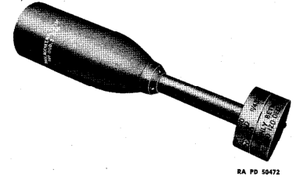7.2-Inch Demolition Rocket
| T37 | |
|---|---|
 | |
| Type | Surface-to-surface rocket |
| Place of origin | United States |
| Service history | |
| Used by | United States Army, United States Navy |
| Production history | |
| Designer | Caltech |
| Designed | 1943 |
| Produced | 1944–1945 |
| Specifications | |
| Weight | 61 lb (28 kg) |
| Length | 35 in (890 mm) |
| Diameter | 7.2 in (180 mm) |
| Warhead | C2 explosive[1] |
| Warhead weight | 32 lb (15 kg) |
|
| |
| Engine | Solid-fuel rocket |
Operational range | 300 yd (0.27 km) |
| Speed | 110 mph (180 km/h) |
Guidance system | None |
The 7.2-Inch Demolition Rocket, also known as the T37, was a 7.2-inch (180 mm) rocket developed and used by the United States military during World War II. Derived from the "Mousetrap" anti-submarine rocket, it was intended for use in demolishing concrete bunkers and fortifications, and saw use from August 1944.
Development
The 7.2-Inch Demolition Rocket was developed by Section L of the National Defense Research Committee, located at Caltech,[2] in late 1943 as a modification of the existing "mousetrap" (7.2-Inch ASW Rocket) rocket for use against heavily fortified ground targets. Assigned to the United States Navy for development and production in July 1944,[3] two versions of the rocket were produced; the T37 HE Demolition Rocket and the T21 Chemical Warfare Rocket.[4] An additional high-explosive rocket, the T24, was planned, but was dropped in favor of the T37.[5] The rockets utilized a standard 2.25-inch (57 mm) rocket motor, fitted with a larger-diameter warhead; a longer-ranged version utilizing a 3.5-inch (89 mm) motor was also produced.[6]
Operational history
The T37 saw its first operational use during Operation Dragoon, the invasion of southern France, in August 1944,[7] fired from 120-round "Woofus" launchers mounted aboard Landing Craft Rocket vessels offshore.[8]
The rocket was also intended to be fired from tanks for the clearing of bunkers and anti-tank obstacles. The initial launcher, dubbed "Cowcatcher", was mounted on the front of M4 Sherman tanks;[9] it was quickly found unsatisfactory, and was replaced by 20-round (T40 "Whiz Bang")[10] and 24-round ("Grand Slam") launchers mounted atop the tank's turret.[7][9] The 20-round launcher could fire its entire loadout of rockets in approximately 10 seconds;[11] however the tank installation was unpopular with crews, as the launcher prevented the tank's turret hatches from being opened.[9]
References
- Citations
- ↑ "U.S. ROCKET, 7.2-IN, DEMOLITION, T37". ORDATA Online. Mine Action Information Center. Retrieved 24 May 2012.
- ↑ von Braun, Ordway III and Dooling 1985, p.97.
- ↑ Hearings of the Committee on Expenditures in the Execuitive Departments. United States House of Representatives. 1947. p. 117.
- ↑ 7.2-Inch Multiple Rocket Launcher M17. Technical Manual. TM9-296. Washington, D.C.: War Department. 9 January 1945. pp. 26–27.
- ↑ Ordnance School Text: Rockets and Launchers, All Types. Aberdeen, Maryland: Ordnance School, Aberdeen Proving Grounds. February 1944. p. 93.
- ↑ "Rocket, Solid Fuel, H.E. (High Explosive), 7.2in.". National Air and Space Museum. Smithsonian Institution. Retrieved 2012-02-29.
- ↑ 7.0 7.1 Parsch 2006
- ↑ Baxter 1968, p.114.
- ↑ 9.0 9.1 9.2 Zaloga 2011, pp.35-36
- ↑ Zaloga 2012, p.16.
- ↑ TM 5–220: Passage Of Obstacles Other Than Mine Fields. War Department Technical Manual. United States War Department. July 1945. p. 50.
- Bibliography
- Baxter, James Phinney (1968). Scientists Against Time. Cambridge, Massachusetts: The MIT Press. p. 114. ISBN 978-0-262-52012-6.
- Parsch, Andreas (2006). "Surface-Launched 7.2-Inch Rockets". Directory of U.S. Military Rockets and Missiles Appendix 4: Undesignated Vehicles. Designation-Systems.net. Retrieved 2012-02-29.
- von Braun, Wernher; Frederick I. Ordway III; Dave Dooling (1985). Space Travel: A History : An Update of History of Rocketry & Space Travel. New York: Harper & Row. ISBN 978-0-06-181898-1.
- Zaloga, Stephen (2011). Armored Attack 1944: U.S. Army Tank Combat in the European Theater from D-Day to the Battle of the Bulge. Mechanicsburg, Pennsylvania: Stackpole Books. pp. 35–36. ISBN 978-0-8117-0769-5.
- Zaloga, Stephen (2012). US Marine Corps Tanks of World War II. New Vanguard 186. New York: Osprey Publishing. p. 16. ISBN 978-1-84908-560-1.
| ||||||||||
| ||||||||||||||||||||||